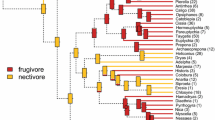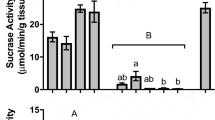Abstract
Plants pollinated and dispersed by different groups of birds offer different kinds of sugars in nectar and fruit pulp. The preferences and physiological traits of avian pollinators and seed dispersers are broadly correlated with the sugar composition of the nectar and fruit that they feed on and appear to have influenced the evolution of the sugar composition of the rewards that plants offer. Hummingbirds prefer sucrose whereas many nectar- and fruit-eating passerines prefer glucose and fructose. Preference for hexoses in passerines seems to be associated with poor sucrose assimilation resulting from two physiological mechanisms: lack of intestinal sucrase activity and fast passage rates. Sucrase activity absence appears to be restricted to a single phylogenetic group (the sturnid-muscicapid lineage). Fast passage rates seem to be characteristic of many small frugivores and to hinder the assimilation of complex nutrients that require hydrolysis before absorption. Hummingbirds have extremely specialized digestive traits that allow them to assimilate sucrose at high rates and with extremely high efficiency. These specialized digestive traits appear not to be present in many nectar-feeding passerines.
Similar content being viewed by others
References
Alpers, D. H., Digestion and absorption of carbohydrates and proteins, in: Physiology of the Gastrointestinal Tract, vol. 2, pp. 1469–1486. Ed. L. R. Johnson. Raven Press, New York 1987.
Antonovics, J. and van Tienderen, P. H., Ontoecogenophyloconstraints. Trends in Ecol. Evol.6 (1991) 166–167.
Baker, H. G., Evolutionary relationships between flowering plants and animals, in: Tropical Forest Ecosystems in Africa and South America: A Comparative Review, pp. 149–159. Eds P. J. Meggers, E. Ayensu and W. D. Duckworth. Smithsonian Institution Press, Washington D.C. 1972.
Baker, H. G., Sugar concentrations in nectars from hummingbird flowers. Biotropica7 (1975) 37–41.
Baker, H. G., Anthecology: Old Testament, New Testament, Apocrypha. N. Z. J. Bot.17 (1979) 431–440.
Baker, H. G., and Baker, I., Some chemical constituents of floral nectars ofErythrina in relation to pollinators and systematics. Allertonia3 (1982) 25–37.
Baker, H. G., and Baker, I., Floral nectar sugar constituents in relation to pollinator type, in: Handbook of Experimental Pollination Ecology, pp. 131–171. Eds C. E. Jones and R. J. Little. Scientific and Academic Editions, New York 1983.
Baker, I., Baker, H. G., and Hodges, S. A., Patterns in the sugar composition of nectar and fruit juices taken by Microchiroptera and Megachiroptera. Biotropica (in press).
Baum, D. A., and Larson, A., Adaptation reviewed: a phylogenetic methodology for studying character macroevolution. Syst. Zool.40 (1991) 1–18.
Bennet, A. F., The achievements of ecological physiology, in: New Directions in Ecological Physiology, pp. 1–10. Eds M. E. Feder, A. F. Bennett, W. W. Burggren and R. B. Huey. Cambridge Univ. Press, New York 1987.
Brugger, K. E., Sucrose as a fruit repellent to American robins (Turdus migratorius). J. Wildl. Mgmt (in press).
Brugger, K. E., and Nelms, C. O., Sucrose avoidance by American robins (Turdus migratorius): implications to control of bird damage in fruit crops. Crop Protect.10 (1992) 455–460.
Búrquez, A., Blue tits,Parus caeruleus, as pollinators of the crown imperial,Fritillaria imperialis, in Britain. Oikos58 (1989) 335–340.
Calder, W. A., On the temperature dependency of optimal nectar concentration for birds. J. theor. Biol.78 (1979) 185–196.
Carpenter, F. L., and Castronova, J. L. Maternal diet selectivity inCalypte anna. Am. Midl. Nat.103 (1980) 175–179.
Coddington, J. A., Cladistic tests of adaptational hypotheses. Cladistics4 (1988) 3–22.
Collins, B. G., Cary, G., and Packard, G., Energy assimilation, expenditure and storage by the brown honeyeaterLichmera indistinta. J. comp. Physiol.137 (1980) 157–163.
Collins, B. G., and Morellini, P. C., The influence of nectar concentration and time of day upon energy intake and energy expenditure by the singing honeyeaterMeliphaga virescens. Physiol. Zool.52 (1979) 165–175.
Collins, B. G., and Paton, D. C., Consequences of differences in body mass, wing length and morphology for nectar-feeding birds. Aust. J. Ecol.14 (1989) 269–289.
Cruden, R. W., and Toledo, V. M., Oriole pollination ofErythrina breviflora (Leguminosae): evidence for a polytypic view of ornithophily. Pl. Syst. Evol.126 (1977) 393–403.
Dethier, V. G., and Goldrich, N., Blowflies: alteration of adult taste responses by chemicals present during development. Science173 (1971) 242–244.
Faegri, K., and van der Pijl, L., The principles of pollination ecology. Pergamon Press, New York 1966.
Ford, H. A., Paton, D. C., and Forde, N., Birds as pollinators of Australian plants. N.Z. J. Bot.17 (1979) 509–519.
Freeman, C. E., and Worthington, R. D., Is there a difference in the sugar composition of cultivated sweet fruits of tropical/subtropical and temperate origins? Biotropica21 (1988) 219–222.
Futuyma, D. S., and Slatkin, M., Epilogue: the study of coevolution, in: Coevolution, pp. 459–464. Eds D. S. Futuyma and M. Slatkin. Sinauer, New York 1983.
Gilbert, L. L., and Rayen, P., Coevolution of Animals and Plants. Univ. of Texas Press. Austin, Texas 1975.
Grant, K. A., and Grant, V., Hummingbirds and Their Flowers. Columbia University Press, New York 1968.
Gould, S. J., The Panda's Thumb. W. W. Norton and Co., New York 1980.
Gryj, E., Martínez del Rio, C., and Baker, I., Avian pollination and nectar use inCombretum fruticosum (Loefl.). Biotropica22 (1990) 266–271.
Hainsworth, F. R., and Wolf, L. L., Nectar characteristics and food selection by hummingbirds. Oecologia25 (1976) 101–113.
Heinrich, B., Energetics of pollination. A. Rev. Ecol. Syst.6 (1975) 139–170.
Herrera, C. M., Adaptation to frugivory of Mediterranean avian seed dispersers. Ecology65 (1984) 609–617.
Hess, E. H., Imprinting in birds. Science146 (1964) 1128–1139.
Howell, D., Bats and pollen: physiological aspects of the syndrome of Chiropterophily. Comp. Biochem. Physiol.48A (1979) 236–276.
Karasov, W. H., Digestion in birds: chemical and physiological determinants, and ecological implications, in: Avian Foraging: Theory, Methodology, and Applications, pp. 391–415. Eds M. L. Morrison, C. J. Ralph, J. Verner and J. R. Jehl Jr. Studies in Avian Biology No. 13, Cooper Ornithological Society, Lawrence, Kansas 1990.
Karasov, W. H., Phan, D., Diamond, J. M., and Carpenter, F. L., Food passage and intestinal nutrient absorption in hummingbirds. Auk103 (1986) 453–464.
Karasov, W. H., and Diamond, J. M., Interplay between physiology and ecology in digestion. BioScience38 (1989) 602–611.
Karasov, W. H., and Levey, D. J., Digestive trade-offs and adaptations of frugivorous birds. Physiol. Zool.63 (1990) 1248–1270.
Levey, D. J., Seed size and fruit-handling techniques of avian frugivores. Am. Nat.129 (1987) 471–485.
Levey, D. J., and Grajal, A., Evolutionary implications of fruit processing and intake limitation in cedar waxwings. Am. Nat.138: 171–189.
Lyon, D. L., and Chadek, C., Exploitation of nectar resources by hummingbirds, bees (Bombus), andDiglossa baritula and its role in the evolution ofPenstemon kunthii. Condor73 (1971) 246–248.
Martínez del Rio, C., Dietary and phylogenetic correlates of intestinal scrase and maltase activity in birds. Physiol. Zool.63 (1990) 987–1011.
Martínez del Rio, C., Sugar preferences in hummingbirds: the influence of subtle chemical differences on food choice. Condor92 (1990) 1022–1030.
Martínez del Rio, C., and Karasov, W. H., Digestion strategies in nectar- and fruit-eating birds and the composition of plant rewards. Am. Nat.136 (1990) 618–637.
Martínez del Rio, C., and Stevens, B. R., Physiological constraint on feeding behavior: intestinal membrane disaccharides of the starling. Science243 (1989) 794–796.
Martínez del Rio, C., Stevens, B. R., Daneke, D., and Andreadis, P. T., Physiological correlates of preference and aversion for sugars in three species of birds. Physiol. Zool.61 (1988) 222–229.
Martínez del Rio, C., Levey, D. J., and Karasov, W. H., Physiological basis and ecological consequences of sugar preferences in cedar waxwings. Auk106 (1989) 64–71.
Martínez del Rio, C., and Restrepo, C., Ecological and behavioral consequences of digestion in frugivorous animals. Vegetatio (in press).
McKey, D., The ecology of coevolved seed dispersal systems, in: Coevolution of Animals and Plants, pp. 159–192. Eds L. E. Gilbert and P. H. Raven. Univ. of Texas Press, Austin 1975.
Michener, C. D., Superfamily Apoidea, in: The Insects of Australia, pp. 943–951. Ed. C.S.I.R.O., Melbourne University Press, Melbourne 1970.
Milton, K., Food choice and digestive strategies of two sympatric primate species. Am. Nat.117 (1981) 496–505.
Moermond, T. C., and Denslow, J. S., Neotropical avian frugivores: patterns of behavior, morphology, and nutrition with consequences for fruit selection, in: Neotropical Ornithology, pp. 865–897. Eds P. A. Buckley, M. S. Foster, E. S. Morton, R. S. Ridley and F. G. Buckley, Ornithological Monographs 45, Allen Press, Lawrence, Kansas 1985.
Morrison, D. W., Efficiency of food utilization by fruit bats. Oecologia45 (1980) 270–273.
Percival, M. S., Types of nectar in angiosperms. New Phytol.60 (1961) 235–281.
Rand, A. L., The flower-adapted tongue of a timaliine bird and its implications. Fieldiana (Zool.)51 (1967) 53–61.
Scogin, R., and Freeman, C. E., Floral pigments and nectar constituents in the genusPuya (Bromeliaceae). Aliso10 (1984) 617–619.
Semenza, G., Intestinal oligosaccharidases and disaccharidases, in: Handbook of Physiology, sect. 6, vol. 5, pp. 2543–2566. Ed. C. F. Code. American Physiological Society, Washington D. C. 1968.
Semenza, G., and Corcelli, A., The absorption of sugars and amino acids across the small intestine, in: Molecular and Cellular Basis of Digestion, pp. 381–412. Eds P. Desnuelle, H. Sjöstrom and A. Norén. Elsevier Science Publishers B. V. New York 1986.
Semenza, G., and Auricchio, S., Small-intestinal disaccharidases, in: The Metabolic Basis of Inherited Disease, pp. 2975–2997. Eds C. R. Scribner, A. L. Beaudet, W. S. Sly and D. Valle. McGraw Hill, New York 1989.
Shafir, E., Effects of sucrose and fructose on carbohydrate and lipid metabolism and the resulting consequences, in: Regulation of Carbohydrate Metabolism, pp. 95–140. Ed. R. Beiner. CRC Press, Boca Raton, Florida 1985.
Sibley, C. G., and Ahlquist, J. E., The relationships of the starlings (Sturnidae: Sturnini) and the mockingbirds (Sturnidae: Mimini). Auk101 (1984) 230–243.
Sibley, C. G., and Ahlquist, J. E., Phylogeny and classification of birds. Yale University Press, New Haven 1990.
Sibley, C. G., Ahlquist, J. E., and Monroe, B. L., A classification of the living birds of the world based on DNA-DNA hybridization studies. Auk105 (1988) 409–423.
Snow, B. K., and Snow, D. W., Birds and Berries. T. Poyser and A. D. Poyser, Calton, England 1971.
Snow, D. W., Tropical frugivorous birds and their food plants: a world survey. Biotropica13 (1981) 1–14.
Stebbins, G. L., Adaptive radiation of reproductive characteristics in angiosperms, I. Pollination mechanisms. A. Rev. Ecol. Syst.1 (1970) 307–326.
Stiles, F. G., Taste preferences, color preferences and flower choice in hummingbirds. Condor78 (1976) 10–26.
Stiles, F. G., Geographical aspects of bird-flower coevolution, with particular reference to Central America. Ann. Mo. bot. Gdn68 (1981) 323–351.
Sunshine, P., and Kretchmer, N., Intestinal disaccharidases: absence in two species of sea lions. Science144 (1964) 850–851.
Van Riper, W., Hummingbird feeding preferences. Auk75 (1958) 100–101.
Wacker, H., Aggeler, R., Kretchmer, N., O'Neill, B., Takesue, Y., and Semenza, G., A two-active site one-polypeptide enzyme: the isomaltase from sea lion small intestinal brush border membrane (its possible phylogenetic relationship with sucrase isomaltase). J. biol. Chem.259 (1984) 4878–4884.
Willson, M. F., Avian frugivory and seed dispersal in eastern North America. Curr. Orn.3 (1986) 223–279.
Author information
Authors and Affiliations
Rights and permissions
About this article
Cite this article
Martínez del Rio, C., Baker, H.G. & Baker, I. Ecological and evolutionary implications of digestive processes: Bird preferences and the sugar constituents of floral nectar and fruit pulp. Experientia 48, 544–551 (1992). https://doi.org/10.1007/BF01920237
Published:
Issue Date:
DOI: https://doi.org/10.1007/BF01920237




